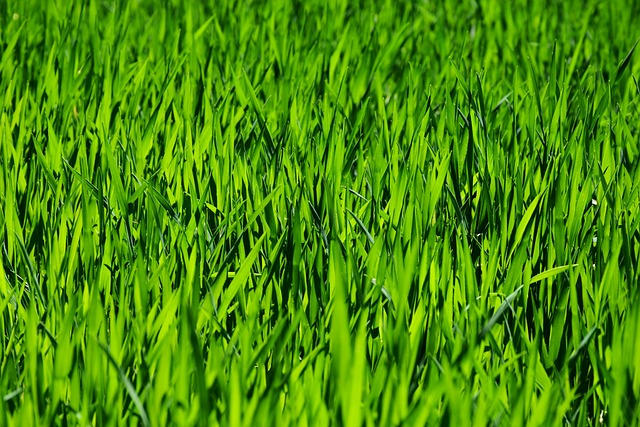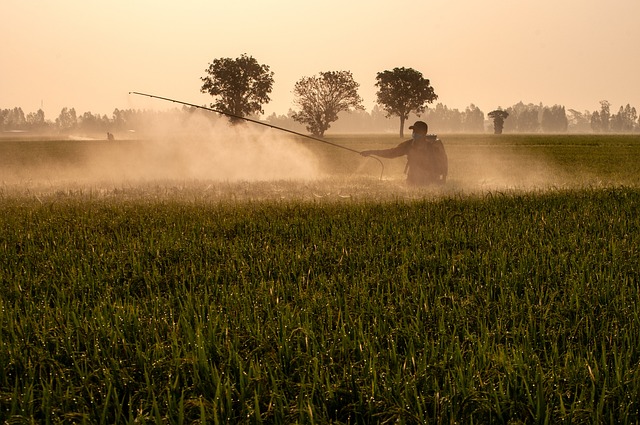To achieve an efficient lawn care and landscaping irrigation system, it's crucial to assess your property's topography, soil types, sun exposure, and the specific water needs of various plant species. Choose an irrigation setup that complements these factors—drip systems for gardens, sprinkler systems for larger areas, and smart controllers for precision watering based on weather forecasts. Eco-conscious systems using recycled rainwater or alternative water sources can significantly reduce water bills and environmental impact. A tailored system with durable pipes, independently controllable zones, and regular maintenance ensures optimal hydration while promoting sustainable lawn care and landscaping practices. Smart technology integration allows for dynamic adjustments to irrigation schedules, leading to healthier plants, minimal water waste, and lower utility costs. Regular upkeep and diligent monitoring are essential for the longevity and efficiency of your irrigation system, ensuring it remains an asset for your lawn care and landscaping maintenance.
effective irrigation system installation is pivotal for maintaining a lush, vibrant landscape. This article delves into the essentials of assessing your property, selecting the ideal irrigation system for lawn care needs, and guiding through a detailed installation process tailored for residential use. We’ll also explore how integrating smart technology can optimize water usage in landscaping, ensuring efficient resource management. Additionally, maintenance and troubleshooting tips are provided to ensure your system operates at peak performance for sustainable lawn care and landscaping success over time.
- Assessing Your Property for Optimal Irrigation System Design
- Choosing the Right Irrigation System for Your Lawn Care Needs
- Step-by-Step Guide to Installing a Residential Irrigation System
- Integrating Smart Technology for Efficient Water Usage in Landscaping
- Maintenance and Troubleshooting Tips for Long-Term Irrigation System Success
Assessing Your Property for Optimal Irrigation System Design

When planning an irrigation system for your property, a thorough assessment is crucial to ensure efficient water use and optimal lawn care and landscaping outcomes. Begin by surveying your landscape’s topography, including slopes, soil types, and sun exposure, as these factors will influence the design of your irrigation layout. Understanding the unique characteristics of your yard allows for tailored water delivery that addresses specific areas which may require more or less hydration. Take note of existing vegetation and plant types, as they have different water needs; for instance, established turf grasses will have different requirements compared to new plantings or flower beds.
After mapping out the land, consider the water source availability and pressure. This step is essential for the irrigation system’s functionality and reliability. The proximity of your water source to the various zones of your landscape should be evaluated to minimize the need for excessive piping, which can lead to water loss due to friction and pressure drops. Additionally, determine if your property benefits from a municipal water supply or relies on well water, as this will dictate the type of system that can be installed. By carefully assessing these elements, you can design an irrigation system that conserves water, promotes healthy lawn care and landscaping practices, and ultimately contributes to a sustainable and lush outdoor environment.
Choosing the Right Irrigation System for Your Lawn Care Needs

When considering the installation of an irrigation system for your lawn care, it’s crucial to assess your specific landscaping needs and the characteristics of your yard. The right irrigation system not only conserves water but also ensures that your grass and plants receive optimal hydration. Factors such as soil type, local climate, water pressure, and plant variety are vital in determining the most suitable system for your lawn. For instance, drip irrigation is an efficient option for gardens with shrubs and flower beds, delivering water directly to the roots without waste. On the other hand, sprinkler systems are ideal for expansive turf areas, offering even coverage and mimicking natural rainfall patterns.
To select a system that aligns with your lawn care objectives, consult with a landscape professional who can evaluate your property and recommend options tailored to your needs. Consider systems equipped with smart controllers that adjust watering schedules based on local weather forecasts, ensuring your lawn is neither overwatered nor under-hydrated. Additionally, explore eco-friendly systems that recycle rainwater or harvest water from other sources, which can significantly reduce your water bill and environmental footprint. Investing in a well-chosen irrigation system for your landscaping can lead to a healthier, more vibrant lawn with less effort on your part.
Step-by-Step Guide to Installing a Residential Irrigation System

Lawn Care and landscaping professionals often emphasize the importance of a well-designed irrigation system for maintaining a healthy, lush landscape. Installing a residential irrigation system involves careful planning and execution to ensure efficient water usage and optimal plant health. To begin, assess your property’s topography, existing water sources, and the specific needs of your lawn and garden areas. This will help you determine the most effective layout for your irrigation system.
Start by marking out the zones that need irrigation on your property. Use a variety of irrigation components such as spray heads, drip emitters, and rotary nozzles to cater to different watering needs—from moistening small flower beds to saturating larger lawn areas. Next, select appropriate pipe materials like PVC or polyethylene for the main lines, ensuring they are placed at a suitable depth to avoid damage from lawn maintenance equipment. Connect the emitters and sprinkler heads to the pipes, making sure each zone is independently controllable for precise watering. Finally, test your system for leaks, proper coverage, and pressure. Once satisfied with the setup, integrate it with an automatic timer or a smart irrigation controller for hassle-free, scheduled watering that conserves water and supports eco-friendly lawn care and landscaping practices. Regular maintenance will prolong the life of your system and keep your landscape thriving.
Integrating Smart Technology for Efficient Water Usage in Landscaping

Incorporating smart technology into modern irrigation systems has revolutionized lawn care and landscaping, offering a more efficient approach to water usage. These advanced systems utilize sensors and weather forecasting data to optimize water distribution, ensuring that every drop of water is used precisely where it’s needed most. This not only promotes lush, green lawns and vibrant landscapes but also conserves water by preventing unnecessary waste. Homeowners and professionals alike can monitor and control these systems remotely, adjusting settings on-the-fly to adapt to changing conditions. As a result, smart irrigation technology represents a significant step forward in sustainable landscape management, aligning with eco-friendly practices while maintaining the aesthetic appeal of outdoor spaces.
Furthermore, integrating smart irrigation systems into lawn care and landscaping regimes can lead to substantial water savings over time. These systems are designed to learn and adapt, becoming more efficient as they collect data on soil moisture, evaporation rates, and plant water use preferences. By delivering precise amounts of water at the optimal times, these systems minimize runoff and waste, ensuring that landscapes receive just enough water to thrive without overconsumption. This level of precision not only supports environmental sustainability but also translates into cost savings for users, making smart irrigation a sound investment for any property with landscaped areas.
Maintenance and Troubleshooting Tips for Long-Term Irrigation System Success

Regular maintenance is the cornerstone of a robust irrigation system, ensuring efficient lawn care and landscaping practices. To maintain optimal performance, it’s advisable to perform routine checks, especially after each irrigation cycle. Start by inspecting the system for any broken or cracked sprinkler heads or pipes that could disrupt water distribution. Clear away debris from filters and screens to prevent clogging, which can hinder water flow and pressure, leading to inadequate irrigation. Adjust sprinklers periodically to align with changing landscaping features, such as new plantings or garden expansions, to ensure even moisture coverage across your lawn. Monitor the system’s control valves and timers to guarantee precise scheduling and avoid overwatering or underwatering.
When it comes to troubleshooting, identifying issues early can save time, resources, and prevent lawn damage. If a zone is not watering, check the lateral lines for breaks or blockages, and repair them as necessary. For sprinkler heads that are spraying erratically, recalibrate them to their correct angle or replace any that are malfunctioning. Pay attention to pressure regulators and flow sensors to maintain balanced water pressure; imbalances can cause uneven water distribution and lead to wet patches or dry spots on your lawn. If you encounter a leak in the mainline, shut off the water supply immediately and address the breach to prevent wastage. Keep detailed records of all maintenance tasks and repairs for future reference, which will aid in diagnosing issues when they arise. By staying vigilant and proactive with maintenance and troubleshooting, your irrigation system will serve as a reliable tool for consistent lawn care and landscaping.
Lawn care and landscaping professionals recognize the significance of a well-designed irrigation system in maintaining a lush, vibrant outdoor space. By meticulously assessing your property and selecting an appropriate irrigation system tailored to your lawn care needs, homeowners can ensure optimal water distribution and efficiency. The step-by-step installation guide provided offers clarity and precision for do-it-yourself enthusiasts, while integrating smart technology enhances the system’s performance and sustainability. Regular maintenance and timely troubleshooting are pivotal for the longevity and effectiveness of your irrigation setup. With these considerations in mind, your lawn care endeavors will flourish with consistent hydration and careful management, reflecting the beauty and resilience of well-tended landscapes.



